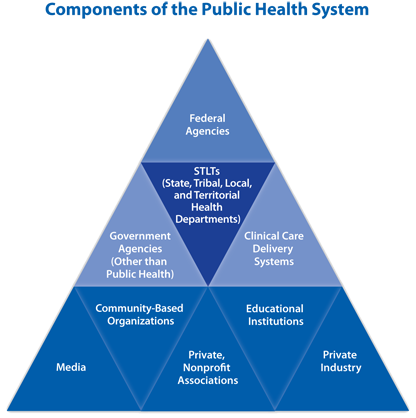Building Capacity of the Public Health System to Improve Population Health through National, Nonprofit Organizations
FOA Links
Need Assistance?
For assistance with the FOA, please view our Frequently Asked Questions.
If you need more information, send us an email.
CDC’s Office for State, Tribal, Local and Territorial Support (OSTLTS) has announced the 25 national nonprofit awardees of this five-year funding opportunity.
In fiscal year 2013, CDC provided funding to the awardees, who provide guidance and technical assistance to people and organizations on the frontlines of public health—such as health departments, community and neighborhood health centers, primary-care delivery systems, and public health institutes.
These partnerships help strengthen the nation’s capacity to deliver public health services through public health departments and community organizations.
For the purpose of this grant initiative, the public health system refers to “activities undertaken within the formal structure of government and the associated efforts of private and voluntary organizations and individuals” (IOM, 1988)1.
About the Initiative
What needs will the initiative address?
This initiative intends to address the need for
- Improved public health systems and organizational efficiencies
- Improved public health workforce
- Increased use of technology and better population data
- Improved planning, implementation, and evaluation of evidence-based public health policies, laws, programs, and services
- Increased use of results-driven partnerships
- Increased availability and access to public health resources and materials
(K. Chapman, G. Weaver, S. Taveras—CDC, 2013)
1Institute of Medicine. The future of public health. Washington: National Academies Press; 1988.
What are the intended outcomes of the initiative?
- Increased adoption of new or proven business improvements that lead to management and administrative efficiencies or cost savings
- Increased availability and accessibility of continuing education and training focused on public health competencies and new skills, including the use of experience-based internships and fellowships
- Increased incorporation of core public health competencies into employee position descriptions and performance evaluations
- Increased integration of state-of-the-art technology into data collection and information systems
- Increased implementation of evidence-based public health programs, policies, and services
- Improved capacity to meet nationally established standards, such as those for health department accreditation
- Establishment and maintenance of diverse public health partnerships for meaningful cooperation and achievement of evidence-based public health strategies and interventions, such as CDC Winnable Battles
- Improved quality, availability, and accessibility of public health education, training, and evaluation tools and resources
What is the strategy of the initiative?
Organizations will provide capacity-building assistance, working toward sustaining and improving the performance of the public health system, with a priority on state, tribal, local, and territorial health departments.
Capacity-building assistance refers to methods for sharing knowledge, developing skills, and creating institutional systems and capacity. These methods may include training, technical consultation and services, information packaging and dissemination, and technology transfer activities.
These organizations will be asked to provide assistance in
- Improving public health and organizational systems
- Building the competencies of the public health workforce
- Improving public health data and Information systems
- Strengthening public health practice and services
- Developing and maintaining public health partnerships
- Improving the provision of public health resources
- Page last reviewed: March 1, 2017
- Page last updated: March 1, 2017
- Content source:


 ShareCompartir
ShareCompartir




